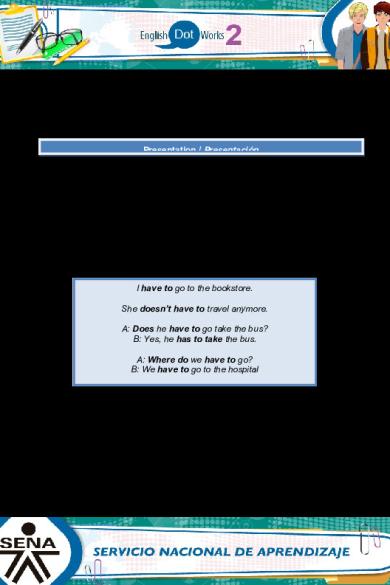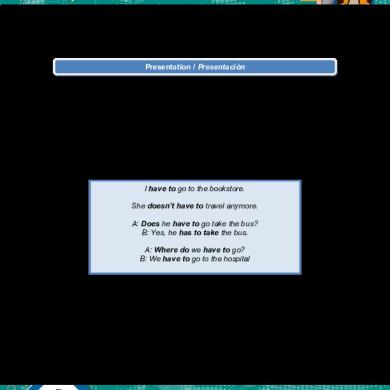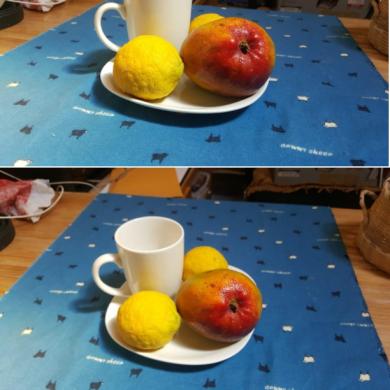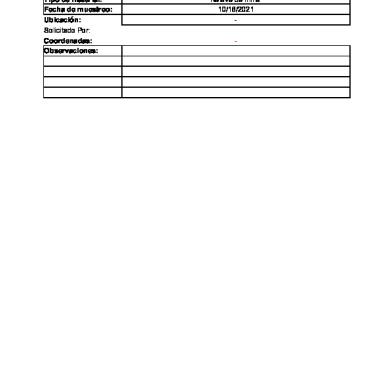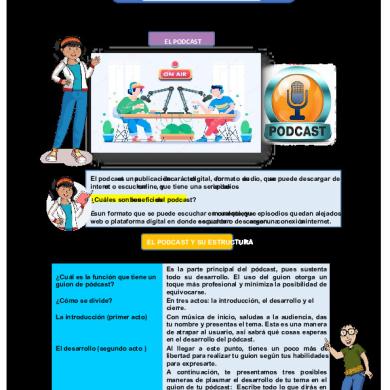* The preview only shows a few pages of manuals at random. You can get the complete content by filling out the form below.
Description
Support material / Material de apoyo Learning activity 4 / Actividad de aprendizaje 4 Presentation / Presentación A. Expressing obligation and lack of obligation / Expresando obligación y falta del obligación To talk about activities we are obliged to do, activities we have no choice about, we use “have to”. / Para hablar de actividades que estamos obligados a hacer, actividades que no son opcionales, usamos “have to”. To talk about things we can choose to do or not, we use “don’t have to”. / Para hablar de actividades en las que podemos elegir entre hacerlas o no, usamos “don’t have to”. I have to go to the bookstore. She doesn’t have to travel anymore. A: Does he have to go take the bus? B: Yes, he has to take the bus. A: Where do we have to go? B: We have to go to the hospital B. Expressing ability and lack of ability / Expresando habilidad o falta de habilidad To talk about our or someone else’s abilities, we use can. / Para hablar de nuestras habilidades o las de alguien más usamos can. To talk about our or someone else’s lack of ability, we use can’t. / Para hablar de la falta de habilidad nuestra o la de alguien más usamos can’t.
I can speak English She can’t swim. A: Can he cook? B: Yes, he can. C. Prepositions of movement / Preposiciones de movimiento We use some words to refer to the movement of an action in space. These words are called “prepositions of movement”. / Usamos algunas palabras para referirnos al movimiento de una acción. Estas palabras se llaman “preposiciones de movimiento”. To Towards Through Into Across Over Along
They are going to the cinema. / Ellos van para el cinema. He was walking towards me. / Él estaba caminando hacia mí. The car is going through a long tunnel. / El carro va a través de un largo túnel. They went into the drug store on the corner. / Ellos entraron en la droguería de la esquina. The train will take you across the city. / El tren te llevará al otro lado de la ciudad. The cat jumped over the table. / El gato saltó sobre la mesa. She is walking along the path. / Ella está caminando a lo largo del camino.
Remember that we can use the vocabulary of the glossary to talk about means of transportation and traveling. / Recuerde que podemos utilizar el vocabulario del glosario para hablar de los medios de transportes y de viaje. She goes to work by car. You have to show your boarding pass at the gate. Fuente de imágenes: SENA
Practice / Práctica A. Complete the sentences below with have to, don’t, can or can’t. Then, look at all the signs and match them to the correct sentences. / Complete las oraciones con have to, don’t have to, can o can’t. Luego, observe las señales y únalas con las oraciones correctas. a. 1. You _______________ use the mobile here. b.
2. Pets _______________ go here. 3. Adults and children over 4 _____________ pay $ 6, but children under 3 ___________ pay.
c.
4. You _____________smoke in the specific area.
d.
5. You ___________ use VISA and American Express but you ___________ use MasterCard.
e.
6. You ______________ eat outside this place. 7. You ________________ authorization.
enter
without
8. You _____________ park your bicycle here.
f. g.
9. __________________ pay for parking here between 8:30 to 5:30.
h.
10. You ________________ drive and text and the same time.
i.
11. You ______________ stay outside the sea. 12. You ______________ pay a fine if you exceed the speed limit.
j. k.
13. You _______________ smoke in this place.
l.
14. You _______________ talk here.
m.
15. You ______________ make any line if you are a client of the bank.
n. o. Fuente de imágenes: SENA
B. Choose the correct option. / Escoja la opción correcta.
The dog is walking over / across / along the street.
The ovoid is moving to / towards / through the boy.
He is cycling into / over / along the beach.
The train is going towards / across / through the tunnel.
The girl is getting over / into / through the car.
The girl is jumping over / along / to the fence.
He is riding into / to / through the pyramids.
Fuente de imágenes: SENA
Production / Producción A. Look at the following obstacle course. Use the prepositions of movement to describe the dog’s course: / Observe la siguiente carrera de obstáculos. Use las preposiciones de movimiento para describir el recorrido del perro:
Fuente: SENA
On your marks, get set, go… The dog is at the starting point…
B. Write sentences about schools, hospitals and churches. Use the prompts in the box and can’t, can, don’t have to and have to. Write as many as possible. / Escriba oraciones acerca de escuelas hospitales e iglesias. Use los enunciados en la caja y can’t, can, don’t y have to. Escriba tantas como pueda. Study Listen to music
Lay down Eat
Obey instructions Run Take medicine Sing Stay in bed Pray
Work hard Do a lot of exams Wear a uniform Have short hair Take a shower Talk
C. Nicole is traveling from Bogota to Frankfurt. Write a text describing her journey from home until she arrives in Frankfurt. Use the prepositions of movements and the vocabulary of means the transportations and traveling. / Nicole viajará de Bogotá a Frankfurt. Escriba un texto para describir su viaje desde casa hasta que llegue a Frankfurt. Use las preposiciones de movimiento y el vocabulario de medios de transportes y viajes.
Fuente: SENA
Nicole’s journey Nicole is traveling from Bogota to Frankfurt…
Document control / Control del documento Name Author
Johanna Vera Diettes Nicole Bruskewitz
Luz Clarena Adaptation Arias
Position
Dependence
Theme expert Dirección de Asesor English Dot Formación Works - Programa Profesional. de Bilingüismo Dirección General Copy editor – Línea de Producción
Centro Agroindustrial. Regional Quindío
Date
August 2014
September 2014
